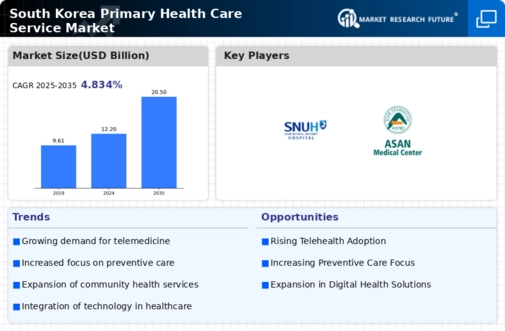Rising Health Awareness
The increasing health consciousness among the South Korean population appears to be a pivotal driver for the primary health-care-service market. As individuals become more informed about health issues, there is a noticeable shift towards seeking preventive care and regular health check-ups. This trend is reflected in the growing demand for primary health-care services, which has seen an increase of approximately 15% in utilization over the past few years. Furthermore, public health campaigns and educational initiatives have contributed to this heightened awareness, encouraging individuals to prioritize their health. Consequently, the primary health-care-service market is likely to expand as more people seek out services that promote wellness and disease prevention.
Focus on Integrated Care Models
The shift towards integrated care models is reshaping the primary health-care-service market. In South Korea, there is a growing emphasis on coordinating care across various health services to improve patient outcomes. Integrated care approaches facilitate collaboration among health care providers, ensuring that patients receive comprehensive and continuous care. This model is particularly beneficial for individuals with complex health needs, as it streamlines access to services and enhances communication among providers. As integrated care becomes more prevalent, the primary health-care-service market is likely to experience growth, driven by the demand for holistic and patient-centered care.
Government Initiatives and Funding
Government policies and funding play a crucial role in shaping the primary health-care-service market. In South Korea, the government has implemented various initiatives aimed at enhancing health care accessibility and affordability. For instance, the introduction of the National Health Insurance program has significantly increased the number of individuals covered, leading to a surge in demand for primary health-care services. Recent data indicates that government spending on health care has risen by 10% annually, which is expected to further bolster the primary health-care-service market. These initiatives not only improve service availability but also encourage innovation and quality improvements within the sector.
Increased Chronic Disease Prevalence
The rising prevalence of chronic diseases in South Korea is a significant driver of the primary health-care-service market. Conditions such as diabetes, hypertension, and cardiovascular diseases are becoming more common, necessitating ongoing management and care. Recent statistics indicate that approximately 30% of the adult population is living with at least one chronic condition, which places a substantial burden on health care services. This trend underscores the need for accessible primary health-care services that can provide continuous monitoring and support for patients. As the demand for chronic disease management grows, the primary health-care-service market is expected to expand accordingly.
Technological Advancements in Health Care
Technological advancements are transforming the landscape of the primary health-care-service market. Innovations such as telemedicine, electronic health records, and mobile health applications are enhancing service delivery and patient engagement. In South Korea, the adoption of telehealth services has increased by over 20% in recent years, allowing patients to access care remotely. This shift not only improves convenience but also expands the reach of primary health-care services to underserved populations. As technology continues to evolve, it is likely to drive further growth in the primary health-care-service market, enabling more efficient and effective care.













Leave a Comment